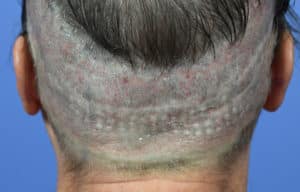
One of the most important factors in evaluating a hair transplant candidate is the availability of their donor supply.
If the available donor area has been depleted by past procedures or by physiological factors, it may restrict what a hair restoration surgeon can address in the future. It’s vital that responsible techniques are used to harvest hair grafts from the donor, many of the techniques that have produced poor cosmetic results have also destroyed hair grafts in the donor region. Poor transplant techniques have often left patients with unnatural hair restoration and damaged the donor grafts that remain as reserves, complicating any effort to correct it.
What Can Cause Graft Loss?
The loss of hair grafts can potentially occur during every step of the surgical hair restoration process. Among the most common causes include: damage to follicles during graft harvesting, poor dissection techniques that lead to transecting grafts, improper graft storage and handling, and placing the transplanted grafts too close together (which can compromise blood supply to grafts, especially if the scalp has suffered effects from sun-damage or smoking).
The existence of too much scar tissue in the donor area can also prove problematic. Too much scar tissue decreases a patient’s scalp mobility, making a subsequent strip excision difficult, and it adversely alters the connective tissue around hair follicles making follicular unit extraction challenging. Significant scarring may also become a cosmetic problem that requires the surgeon to leave a significant amount of hair in the donor area just to mask it. The donor supply can also be depleted by transplanting hair too aggressively in single regions, paying no mind to future hair loss.
Outdated Techniques Effect On Donor Supply
Wasting donor hair was a huge drawback with hair transplants that utilized old plug techniques prior to the advent of follicular units. One of the reasons this was such a prominent problem with outdated techniques stems from a phenomenon called “doughnutting,” in which the centers of transplanted grafts received insufficient oxygen so that only the hair in the perimeter of the grafts often survived. This was commonplace with 4- and 5-mm plugs, but it also occurred with 3-mm micro-grafts.
The second problem stemmed from reckless techniques, which led to the transaction of the bottom of hair follicles when the sharp punch failed to follow the angle of the hair grafts as they were being harvested.
It wasn’t until the development of Follicular Unit Transplantation (FUT) in the mid-1990s, where stereo-microscopes were first used to carefully dissect grafts from the harvested donor strip, that the age-old problems of donor hair waste were mitigated and in some cases eliminated.
Regrettably, after decades of improper techniques, there are thousands of patients who now seek repair for their old procedures, and with depleted donor hair the task is made all the more difficult to correct.
Contact The Gabel Center
To learn more about hair loss, the latest medications, and the latest techniques in hair restoration and hair transplant surgery, contact Dr. Gabel’s Hair Transplant Oregon office by phone or by completing our online form. Our team at the Gabel Center looks forward to your visit and discussing these matters with you in greater detail.
